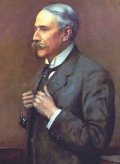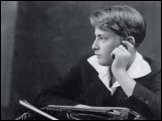
Edward Elgar
Edward Elgar, undoubtedly the greatest English composer since Handel, and the writer of quintessentially English music, was a virtual unknown in 1898. He had little formal training in music. A few pieces had acheived local success, but he struggled to make a living teaching at a girls' school.
One day, he returned home after a long teaching day, and to relax he starting improving at the keyboard. A simple, stately melody emerged that would easily have been lost within his daydream had his wife not commented on it.
The simple theme soon grew into one of the most popular pieces of classical music, and one that certainly put Elgar on the musical map.
The piece was
Variations On An Original Theme, opus 36, now known as the
Enigma Variations. The “Enigma” refers to several layers of riddle embedded within the music, some simple, some unsolved to this day.
Victorian England at the turn of the 19th century was fascinated with puzzles. There were books, magazines and even entire societies devoted to crosswords, secret codes, cyphers, acrostics, anagrams and riddles. Edward Elgar was a great fan of this fad.
At its simplest level, each variation refers to a friend of the Elgars, based on their personalities, and physical and emotional chracteristics.
 |
C.A.E. - After a simple introduction of the theme comes a depiction of Elgar's wife, Caroline Alice Elgar, who stood by him in his lean times and was his inspiration. |
 |
H.D.S.-P. - Hew David Steuart-Powell was a pianist who used to play with Elgar in chamber works. His practice of loosening his fingers on the keyboard is refered to in this variation. |
 |
R.B.T. - Richard Baxter Townsend, one time Cambridge scholar, American cattle rancher and gold prospector. His curiously high-pitched voice is represented. |
 |
W.M.B. - William Meath Baker, nicknamed “The Squire” by the Elgars, was famous for organising everybody's day, then leaving the room with a slam of the door. |
 |
R.P.A. - Richard Penrose Arnold, studious and a great lover of music, represented by the basses, his conversation interupted by great peals of laughter, played by the winds. |
 |
YSOBEL - Isabel Fitton, a keen viola player and student of Elgar. One of the difficult exercises for beginners is 'crossing the strings' and this Variation makes much play of this. |
 |
TROYTE - Arthur Troyte Griffith who tried and failed to learn to play the piano. His attempts are depicted as are Elgar's attempts to bring order out of chaos. |
 |
W.N. - Winifred Norbury a neighbour and excellent pianist, on whom Elgar would often try out his new musical ideas. |
 |
NIMROD - August Johannes Jaeger, music publisher and staunch friend of Elgar. “Nimrod”, the mythical hunter refers to “Jaeger”, German for “hunter”. |
 |
DORABELLA - Dora Penny, long-time friend of the Elgars, and later his biographer. The nickname is from Mozart's Cosi fan Tutte. |
 |
G.R.S. - George Robertson Sinclair, friend and organist. The music depicts his bulldog Dan frolicking in the river Why. |
 |
B.G.N. - Basil G. Nevinson, a cellist in the same trio as the pianist H.D. Steuart-Powell (Variation II) with Elgar as violinist. Beautiful passages for the cello. |
 |
??? - An enigma within an enigma. The unknown thriteenth variation. Elgar says it was a woman recently departed on an ocean voyage, hence the quote from Mendelsshon's “Calm Sea and Prosperous Voyage”. Perhaps an old flame? |
 |
E.D.U. - Edoo, a pet name for Elgar himself. |
A greater enigma is an undisclosed and unsolved musical theme that is refered to in the variations (perhaps as disjointed phrases, or perhaps as counterpoint). Elgar refers to it as:
The enigma I will not explain - its 'dark saying' must be left unguessed, and I warn you that the apparent connection between the Variations and the Theme is often of the slightest texture; further, through and over the whole set another and larger theme 'goes', but is not played.... So the principal Theme never appears, even as in some late dramas ... the chief character is never on stage.
Various suggestions as to the likely theme range from
Rule Britannia to a simple major scale. Elgar encouraged discussion as to the solution, but unfortunately took the answeer with him to the grave.
Elgar - Violin Concerto - Yehudi Menuhin
Elgar began his musical traning with aspirations of becoming a violinist. After several years of learning, he asked his teacher whether he would ever be a great violinist. His teacher replied simply “No”. From that moment onwards, Elgar was a composer.
He wrote just one work for his instrument, the monumental
Violin Concerto in B minor. They say the English have trouble expressing their emotions, but Elgar's
Violin Concerto must be the exception. Richly expressive, deceptively simple, wonderfully intricate. A challenge for any soloist.
Yehudi Menuhin

Yehudi Menuhin
Yehudi Menuhin was a 16 year old prodigy when the great Elgar, then 75, invited him to perform his
Violin Concerto. Elgar conducted and the recording sealed both Menuhin's and Elgar's reputations. Menuhin's phrasing and technique were impeccable, and this recording put the Elgar
Violin Concerto up amongst the greatest of all. It is almost impossible to believe that somebody so young could perform with such maturity.
Our recommended CD today is that 1932 recording with a very young Menuhin, and a stately Elgar, with all the hisses and crackles from a time when recording was still in its infancy. Yet many say this recording of the concerto has never been equalled, and there are few rivals to the
Enigma Variations.
If you absolutely cannot put up with mono sound and the pops and crackles of this CD, then we would recommend the
Kennedy, Simon Rattle recording of the
Violin Concerto, slow, delicate and full of feeling, it is probably the modern keeper of the flame.
The Elgar recording of the
Enigma Variations were recorded even earlier (1928), and while the interpretation is unsurpassed, the recording is certainly old. For a contemporary rendition, it is impossible to go past the
John Eliot Gardiner recording with the Vienna Philharmonic. Extremely English with a classical Viennese, even Brahmsian touch.
But for the purists, for those who like to hear originals speaking through the decades, the Elgar/Menuhin combination is magical.
Please support Good-Music-Guide.com
by purchasing this CD using this link.

Track Listing
Edward Elgar
Violin Concerto in B minor, opus 61
Variations On An Origianal Theme ('Enigma') Opus 36
Yehudi Menuhin, violin
London Philharmonic Orchestra
Edward Elgar, conductor
Violin Concerto In B minor, Op.61
- Allegro
- Andante
- Allegro molto
- Cadenza (accompagnata: Lento) - Allegro molto
Variations On An Origianal Theme ('Enigma'), Op. 36
- Theme (Andante)
- I: L'istesso tempo
- II: Allegro
- III: Allegretto
- IV: Allegro di molto
- V: Moderato
- VI: Andantino
- VII: Presto
- VIII: Allegretto
- IX: Adagio
- X: Allegretto
- XI: Allegro di molto
- XII: Andante
- XIII: Moderato
- XIV: Finale: Allegro